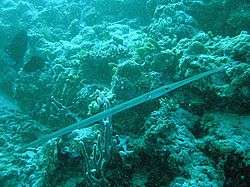Cornetfish
| Cornetfish Temporal range: 33–0 Ma | |
|---|---|
 | |
| Bluespotted cornetfish, Fistularia commersonii | |
| Scientific classification | |
| Kingdom: | Animalia |
| Phylum: | Chordata |
| Class: | Actinopterygii |
| Order: | Syngnathiformes |
| Family: | Fistulariidae Blainville, 1818 |
| Genus: | Fistularia Linnaeus, 1758 |
| Species | |
|
See text. | |
The cornetfishes or flutemouths[2] are a small family, the Fistulariidae, of extremely elongated fishes in the order Syngnathiformes. The family consists of a single genus, Fistularia, with four species, found worldwide in tropical and subtropical marine environments.
Ranging up to 200 cm (6.6 ft) in length, cornetfishes are as thin and elongated as many eels, but are distinguished by very long snouts, distinct dorsal and anal fins, and forked caudal fins whose center rays form a lengthy filament. The lateral line is well-developed and extends onto the caudal filament.[3]
They generally live in coastal waters or on coral reefs, where they feed on small fishes, crustaceans, and other invertebrates.[3]
Cornetfish are of minor interest for fishing, and can be found in local markets within their range.
Species
Currently, four recognized species are placed in this genus:[4]
- Fistularia commersonii Rüppell, 1838 (blue-spotted cornetfish)
- Fistularia corneta C. H. Gilbert & Starks, 1904 (Pacific cornetfish)
- Fistularia petimba Lacépède, 1803 (red cornetfish)
- Fistularia tabacaria Linnaeus, 1758 (cornetfish)
References
- ↑ Sepkoski, Jack (2002). "A compendium of fossil marine animal genera". Bulletins of American Paleontology. 364: 560. Archived from the original on 2009-02-20. Retrieved 2007-12-25.
- ↑ Fishes of Australia, FISTULARIIDAE Flutemouths (Museum Victoria)
- 1 2 Orr, J.W.; Pietsch, T.W. (1998). Paxton, J.R.; Eschmeyer, W.N., eds. Encyclopedia of Fishes. San Diego: Academic Press. pp. 170–171. ISBN 0-12-547665-5.
- ↑ Froese, Rainer, and Daniel Pauly, eds. (2012). Species of Fistularia in FishBase. October 2012 version.
External links
- Cornetfish video from Makena Landing, Maui Hawaii
- YouTube video of a group of cornetfish taken in Shark's Bay, Egypt.
- Genetic bottlenecks and successful biological invasions: the case of a recent Lessepsian migrant by Daniel Golani, Ernesto Azzurro, Maria Corsini-Foka, Manuela Falautano, Franco Andaloro, and Giacomo Bernardi